Sensitivity Analysis of Urban Landscape Lake Transparency Based on Machine Learning in Taiyuan City
Abstract
1. Introduction
2. Materials and Methods
2.1. Study Area and Data Acquisition
2.2. Description of Water Quality Data
2.3. Sensitivity Analysis Model
2.4. Cross-Validation
2.5. Data Selection
2.6. Data Normalization
2.7. Model Evaluation
3. Results
3.1. Water Quality Status
3.2. ULLs with Surface Water as the Main Water Source
3.2.1. Sobol Sensitivity Analysis
3.2.2. Morris Sensitivity Analysis
3.3. ULLs with Tap Water as the Main Water Source
3.3.1. Sobol Sensitivity Analysis
3.3.2. Morris Sensitivity Analysis
3.4. ULLs with Rainwater Storage Function
3.4.1. Sobol Sensitivity Analysis
3.4.2. Morris Sensitivity Analysis
3.5. Key Factors Influencing Water Quality in ULLs
4. Discussion
4.1. ULLs with Surface Water as the Main Water Source
4.2. ULLs with Tap Water as the Main Water Source
4.3. ULLs with Rainwater Storage Function
4.4. Water Quality Management Strategies for ULLs
- Enhanced algae management. Eutrophication and algal blooms are significant water quality issues in ULLs, which require focused monitoring and the management of algal growth. Regular maintenance, the use of algal growth inhibitors, and the introduction of natural predators (e.g., certain fish species) should be employed to control algal populations. Furthermore, aquatic plants should be promptly cleared to prevent overgrowth and reduce the potential for algal proliferation;
- Optimization of HRT. Water flow and quality should be improved by increasing flow paths and retention areas, controlling inflow rates, and optimizing the hydraulic structure of ULLs [18];
- Control of suspended solids. Runoff management should be strengthened to reduce soil erosion and prevent particulate and pollutant influx into water bodies. Greening efforts around lakes should be enhanced to stabilize the soil [39];
- Nutrient load management. Land use management around water bodies should be improved to reduce nutrient inflow [41]. Ecological restoration should be improved to enhance the lake’s self-purification capacity [42]. Lake sediments should be regularly dredged to effectively reduce the accumulation and release of nutrients [43];
- Increase dissolved oxygen levels. Oxygen levels should be enhanced by adding aquatic vegetation and installing surface aerators to directly improve water transparency [44];
- Strengthened monitoring and regulation. Monitoring systems should be established and improved to track changes in key parameters in real time and adjust management measures accordingly. During the eutrophication-prone summer and autumn seasons, there should be a focus on enhanced monitoring of algal blooms, and water quality monitoring indicators should be adjusted as needed. For instance, water transparency monitoring should be implemented; also, during seasons prone to algal blooms, water quality parameters that are highly sensitive to transparency should be monitored;
- Public participation and education. It is necessary to raise public awareness of the importance of water resource protection and encourage participation in water environment protection activities, such as pollutant discharge reduction and cleanup efforts.
4.5. Potential Significance and Limitations
5. Conclusions
Author Contributions
Funding
Institutional Review Board Statement
Informed Consent Statement
Data Availability Statement
Conflicts of Interest
Abbreviations
| ULLs | Urban landscape lakes |
| T | Temperature |
| DO | Dissolved oxygen |
| TP | Total phosphorus |
| Chl-a | Chlorophyll a |
| ISS | Inorganic suspended solids |
| COD | Chemical oxygen demand |
| NO3−-N | Nitrate nitrogen |
| NH4+-N | Ammonium nitrogen |
References
- Chang, N.N.; Wang, X.C.; Song, J.; Han, J.X.; Ao, D. A novel index for assessing the water quality of urban landscape lakes based on water transparency. Sci. Total Environ. 2020, 735, 139351. [Google Scholar] [CrossRef] [PubMed]
- Ao, D. Reclaimed Water Reuse for Replenishing Urban Waters in Water Dificient Cities: Theories and Technologies for Landscape Water Quality Control; Xi’an University of Architecture and Technology: Xi’an, China, 2018. [Google Scholar]
- Wu, Q.; Li, X.H.; Mou, X. Impacts of meteorological variations on urban lake water quality: A sensitivity analysis for 12 urban lakes with different trophic states. Aquat. Sci. 2014, 76, 339–351. [Google Scholar] [CrossRef]
- Mei, Z.J.; Li, C.; Zhao, J.; Li, Z.X.; Chen, K.Y.; Huang, X.; Zhao, Z.Y. The temporal and spatial evolution characteristics and driving factors of ecosystem service bundles in Anhui Province, China. Land 2024, 13, 736. [Google Scholar] [CrossRef]
- Venkata Vara Prasad, D.; Venkataramama, L.Y.; Kumar, P.S.; Prasannamedha, G.; Harshana, S.; Srividya, S.J. Analysis and prediction of water quality using deep learning and auto deep learning techniques. Sci. Total Environ. 2022, 821, 153311. [Google Scholar] [CrossRef]
- Marc Macias-Fauria, P.J.; Zimov, N.; Maihi, Y. Pleistocene Arctic megafaunal evological engineering as a natural climate solution? Philos. Trans. R. Soc. B 2020, 375, 20190122. [Google Scholar] [CrossRef]
- Saltelli, A.; Ratto, M.; Cariboni, J.; Gatelli, D.; Saisana, M.; Tarantola, M. Global Sensitivity Analysis: The Primer; John Wiley & Sons: Hoboken, NJ, USA, 2007. [Google Scholar]
- Saltelli, A.; Annoni, P.; D’Hombres, B. How to avoid a perfunctory sensitivity analysis. Procedia Soc. Behav. Sci. 2010, 2, 7592–7594. [Google Scholar] [CrossRef]
- Hsieh, N.H.; Reish, B.; Frederic, Y.B.; Weihsueh, A.C. Applying a global sensitivity analysis workflow to improve the computational efficiencies in Physiologically-Based Pharmacokinetic Modeling. Front. Pharmacol. 2018, 9, 588. [Google Scholar] [CrossRef] [PubMed]
- Xue, H.L.; Tian, X.L.; Wang, B.; Sun, S.C.; Cao, T.J. Comparison of global sensitivity analysis techniques based on a process-based model CROBAS. J. Appl. Ecol. 2021, 32, 134–144. [Google Scholar]
- Norton, J.P. Algebraic sensitivity analyysis of environmental models. Environ. Model. Softw. 2008, 23, 963–972. [Google Scholar] [CrossRef]
- Pianosi, F.; Beven, K.; Freer, J.; Hall, J.W.; Rougier, J.; Stephenson, D.B.; Wagener, T. Sensitivity analysis of environmental models: A systematic review with practical workflow. Environ. Model. Softw. 2016, 79, 214–232. [Google Scholar] [CrossRef]
- Turanyi, T. Sensitivity analysis of complex kinetic systems. Tools and applications. J. Math. Chem. 1990, 5, 203–248. [Google Scholar] [CrossRef]
- Tian, W. A review of sensitivity analysis methods in building energy analysis. Renew. Sustain. Energy Rev. 2013, 20, 411–419. [Google Scholar] [CrossRef]
- Wainwright, H.M.; Finsterle, S.; Jung, Y.; Zhou, Q.; Birkholzer, J.T. Making sense of global sensitivity analyses. Comput. Geosci. 2014, 65, 84–94. [Google Scholar] [CrossRef]
- Liu, J.; Sun, D.; Zhang, Y.L.; Li, Y.M. Prelassification improves relationships between water clarity, light attenuation, and suspended particulates in turbid inland waters. Hydrobiologia 2013, 711, 71–86. [Google Scholar] [CrossRef]
- Lee, L.H.; Lee, Y.D. The impact of water quality on the visual and olfactory satisfaction of tourists. Ocean Coast. Manag. 2015, 105, 92–99. [Google Scholar] [CrossRef]
- Chang, N.N.; Zhang, Q.H.; Wang, Q.; Luo, L.; Wang, X.C.; Xiong, J.Q.; Han, J.X. Current status and characteristics of urban landscape lakes in China. Sci. Total Environ. 2020, 712, 135669. [Google Scholar] [CrossRef]
- Xiang, X.J.; Li, Q.; Khan, X.; Khalaf, O.I. Urban water resource management for sustainable environment planning using artificial intelligence techniques. Environ. Impact Assess. Rev. 2021, 86, 106515. [Google Scholar] [CrossRef]
- Uddin, M.G.; Nash, S.N.; Olbert, A.I. A review of water quality index models and their use for assessing surface water quality. Ecol. Indic. 2021, 122, 107218. [Google Scholar] [CrossRef]
- Kouadri, S.; Elbeltage, A.; Islam, A.R.M.; Kateb, S. Performance of machine learning methods in predicting water quality index based on irregular data set: Application on Illizi region (Algerian southeast). Appl. Water Sci. 2021, 11, 190. [Google Scholar] [CrossRef]
- Xu, R.C.; Peng, Y.; Hu, Z.B.; Hu, X.Y. The spatiotemporal characteristics of water quality and main controlling factors of algal blooms in Tai Lake, China. Sustainability 2022, 14, 5710. [Google Scholar] [CrossRef]
- Jiang, L.; Li, Y.P.; Zhao, X.; Martin, R.T.; Wang, W.C.; Zhang, S.S.; Sarpong, L.; Asmaa, Q.; Pan, B.Z. Parameter uncertainty and sensitivity analysis of water quality model in Lake Taihu, China. Ecohydrol. Model. 2018, 375, 1–12. [Google Scholar] [CrossRef]
- Wu, W.Y.; Zhao, X.H.; Zhang, X.Y.; Wu, X.X.; Zhao, Y.H.; Guo, Q.C.; Yao, L.S.; Liu, X. An ordered multi-objective fuzzy stochastic approach to sustainable water resources management: A case study from Taiyuan City, China. Water Supply 2024, 24, 865–888. [Google Scholar] [CrossRef]
- Sajib, A.M.; Diganta, M.T.M.; Moniruzzaman, M.; Rahman, A.; Dabrowski, T.; Uddin, M.G.; Olber, A.I. Assessing water quality of an ecologically critical urban canal incorporating machine learning approaches. Ecol. Inform. 2024, 80, 102514. [Google Scholar] [CrossRef]
- Jia, Z.L.; Chang, X.; Duan, T.T.; Wang, X.; Wei, T.; Li, Y.X. Water quality responses to rainfall and surrounding land uses in ruban lakes. J. Environ. Manag. 2021, 298, 113514. [Google Scholar] [CrossRef]
- Liu, S.Y.; Li, X.Y.; Ding, R.; Pan, Y.W.; Ge, X.Y.; Ma, W.F. Transport model simulation prediction and environmental risk assessment of pyrethroid insecticides in urban artificial lakes caused by rainfall: A case study of Cloud Mountain Park in subhumid climate zone. J. Environ. Manag. 2023, 343, 118156. [Google Scholar] [CrossRef]
- Wei, Y.; Li, Y.X.; Liu, Y.; Xu, M.X.; Zhang, L.P.; Deng, Q.L. Impacts of rainfall intensity and urbanization on water environment of urban lakes. Ecohydrol. Hydrobiol. 2020, 20, 513–524. [Google Scholar] [CrossRef]
- Sobol, I.M. Global sensitivity indices for nonlinear mathematical models and their Monte Carlo estimates. Math. Comput. Simul. 2001, 55, 271–280. [Google Scholar] [CrossRef]
- Saltelli, A.; Annoni, P.; Azzini, I.; Campolongo, F.; Ratto, M.; Tarantola, S. Variance based sensitivity analysis of model output. Design and estimator for the total sensitivity index. Comput. Phys. Commun. 2010, 181, 259–270. [Google Scholar] [CrossRef]
- Borgonovo, E. A new uncertainty importance measure. Reliab. Eng. Syst. Saf. 2007, 92, 771–784. [Google Scholar] [CrossRef]
- Yang, J.; Zheng, Y.; Zhang, W.; Zhou, Y.C.; Zhang, Y.P. Comparative analysis of machine learning methods for prediction of chlorophyll-a in a river with different hydrology characteristivs: A case study in Fuchun River, China. J. Environ. Manag. 2024, 364, 121386. [Google Scholar] [CrossRef]
- Feng, L.; Hou, X.J.; Zheng, Y. Monitoring and understanding the water transparency changes of fifty large lakes on the Yangtze Plain based on long-term MODIS observations. Remote Sens. Environ. 2019, 221, 675–686. [Google Scholar] [CrossRef]
- Zheng, X.N.; Wu, D.X.; Huang, C.Q.; Wu, Q.Y.; Guan, Y.T. Impacts of hydraulic retention time and inflow water quality on algal growth in a shallow lake supplied with reclaimed water. Water Cycle 2022, 3, 71–78. [Google Scholar] [CrossRef]
- Shan, X.; Li, C.G.; Li, F. Water quality variation of a typical urban landscape river replenished with reclaimed water. Water Cycle 2023, 4, 137–144. [Google Scholar] [CrossRef]
- Chang, N.N. Study on the Comrehensive Index for Water Landscape Effect Assessing of Urban Water Bodies, in Envrionmental Science and Engineering; Xi’an University of Architecture and Technology: Xi’an, China, 2020. [Google Scholar]
- Cao, J.; Hou, Z.Y.; Li, Z.K.; Chu, Z.S.; Yang, P.P.; Zheng, B.H. Succession of phytoplankton functional groups and their driving factors in a subtropical plateau lake. Sci. Total Environ. 2018, 631, 1127–1137. [Google Scholar] [CrossRef] [PubMed]
- Yu, Z.; Yang, K.; Luo, Y.; Yang, Y.L. Secchi depth inversion and its temporal and spatial variation analysis—A case study of nine plateau lakes in Yunnan Province of China. Int. J. Appl. Earth Obs. Geoinf. 2021, 100, 102344. [Google Scholar] [CrossRef]
- Chen, X.C.; Huang, X.C.; He, S.B.; Yu, X.J.; Sun, M.J.; Wang, X.D.; Kong, H.N. Pilot-scale study on preserving eutrophic landscape pond water with a combined recycling purification system. Ecol. Eng. 2013, 61, 383–389. [Google Scholar] [CrossRef]
- Gao, C.; Xu, Z.T.; Yan, X.J.; Wang, G.D.; Lin, X.P.; Zhang, J.C.; Guo, X. Coupling the measures of pollution source control and water replenishment to improve water quality in the catchment scale of Qianshan River Basin. Environ. Pollut. 2024, 341, 122899. [Google Scholar] [CrossRef] [PubMed]
- Wang, Q.; Zhang, Q.H.; Dzakpasu, M.; Lian, B. Development of an indicator for characterizing particle size distribution and quality of stormwater runoff. Environ. Sci. Pollut. Res. 2018, 25, 7991–8001. [Google Scholar] [CrossRef] [PubMed]
- Dunalska, J.A. Abiotic–biotic method of water treatment in a shore of lake—A new strategy for protection of urban lakes. Ecohydrol. Hydrobiol. 2018, 18, 454–458. [Google Scholar] [CrossRef]
- Huser, B.J.; Futter, M.; Lee, J.T.; Perniel, M. In-lake measures for phosphorus control: The most feasible and cost-effective solution for long-term management of water quality in urban lakes. Water Res. 2016, 97, 142–152. [Google Scholar] [CrossRef] [PubMed]
- Parr, L.B.; Perkins, R.G.; Mason, C.F. Reduction in photosynthetic efficiency of Cladophora glomerata, induced by overlying canopies of Lemna spp. Water Res. 2002, 36, 1735–1742. [Google Scholar] [CrossRef] [PubMed]
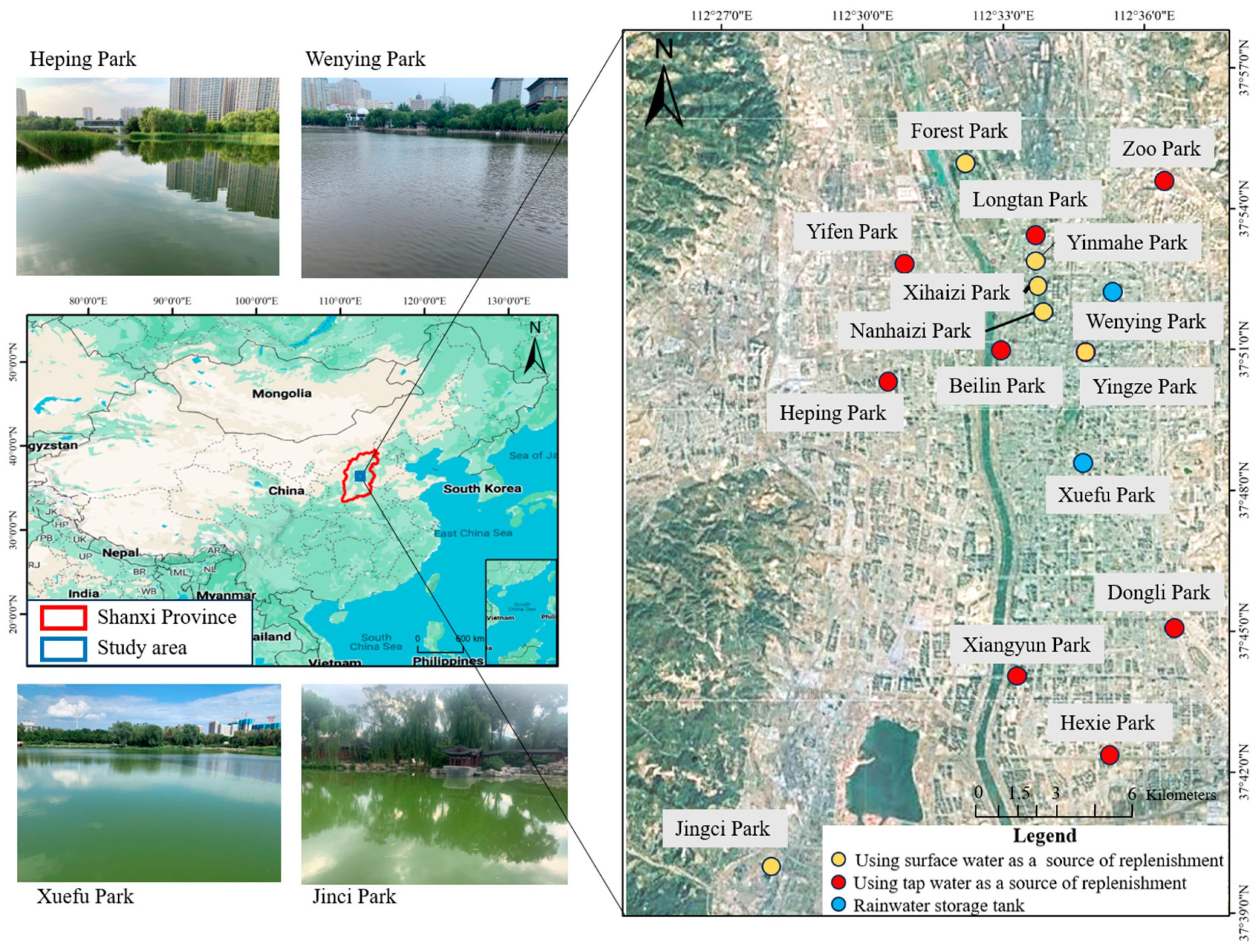
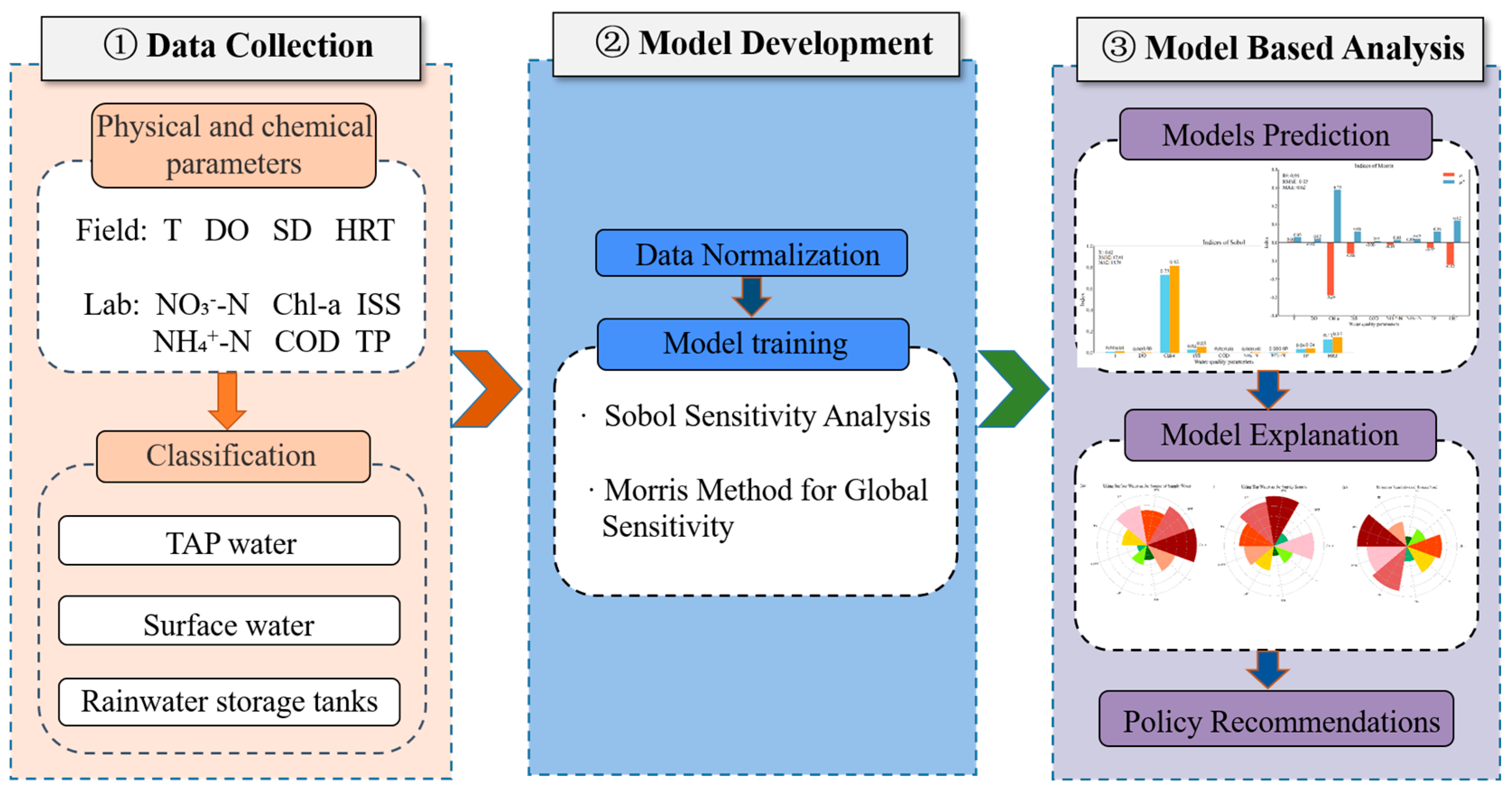


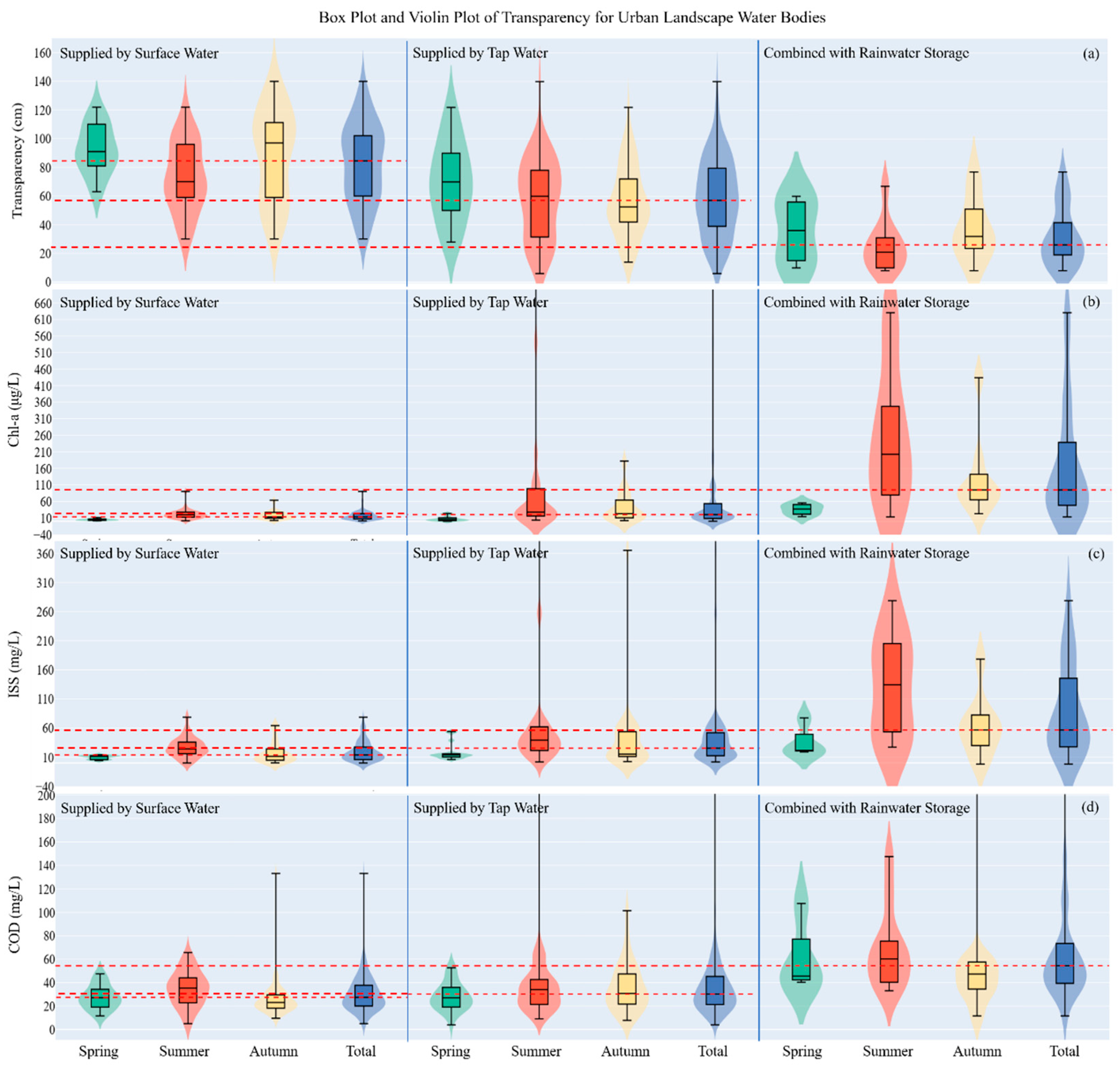
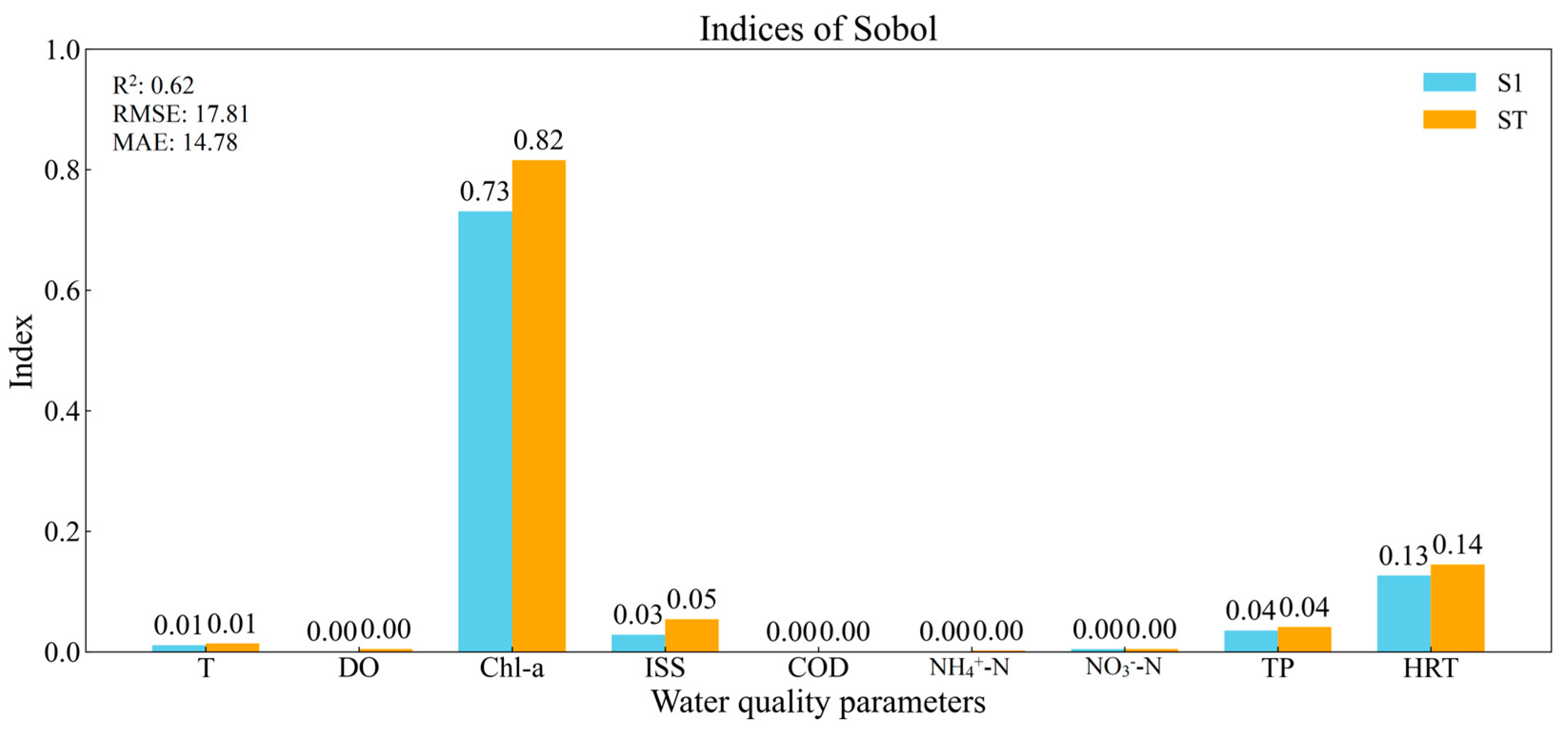
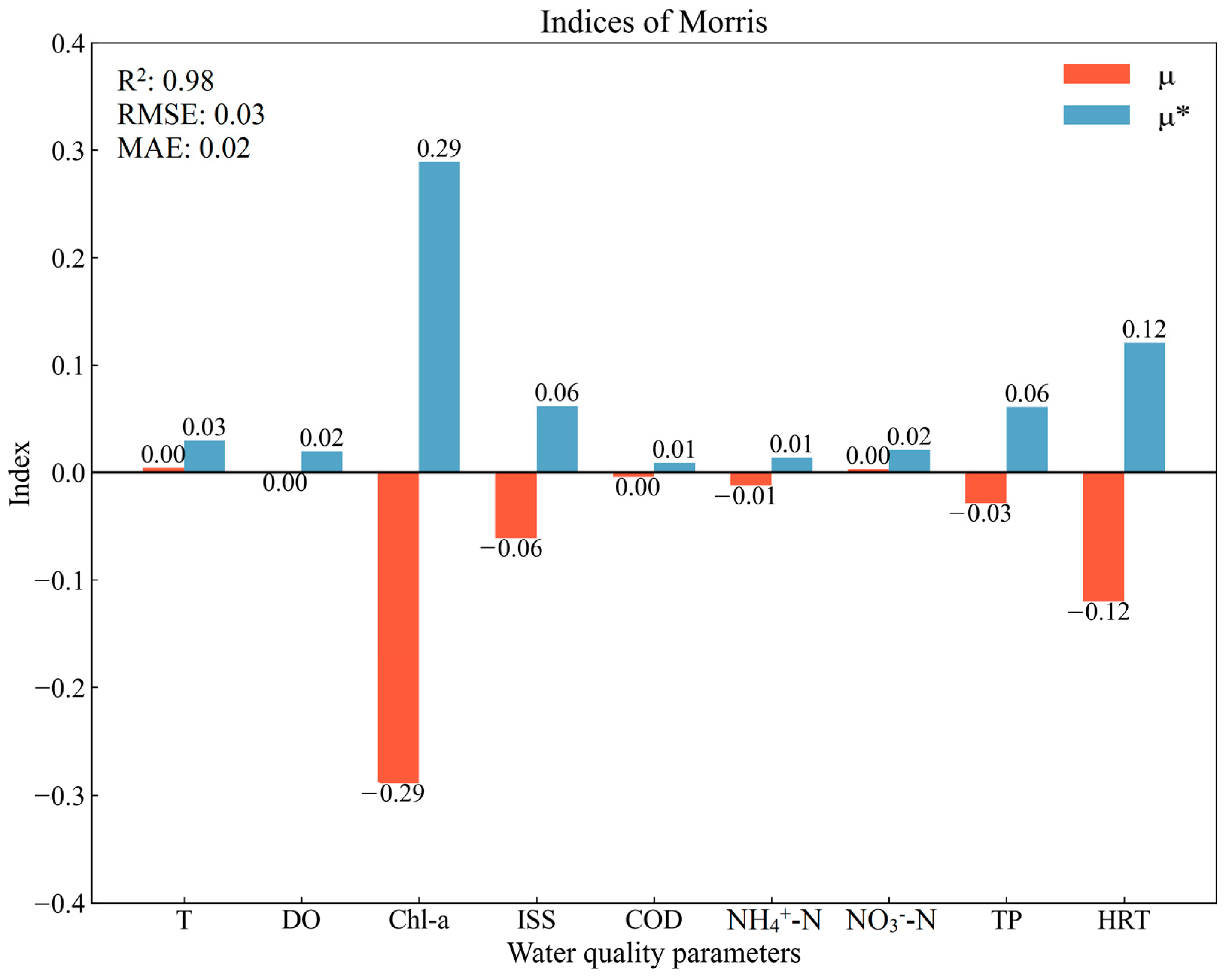


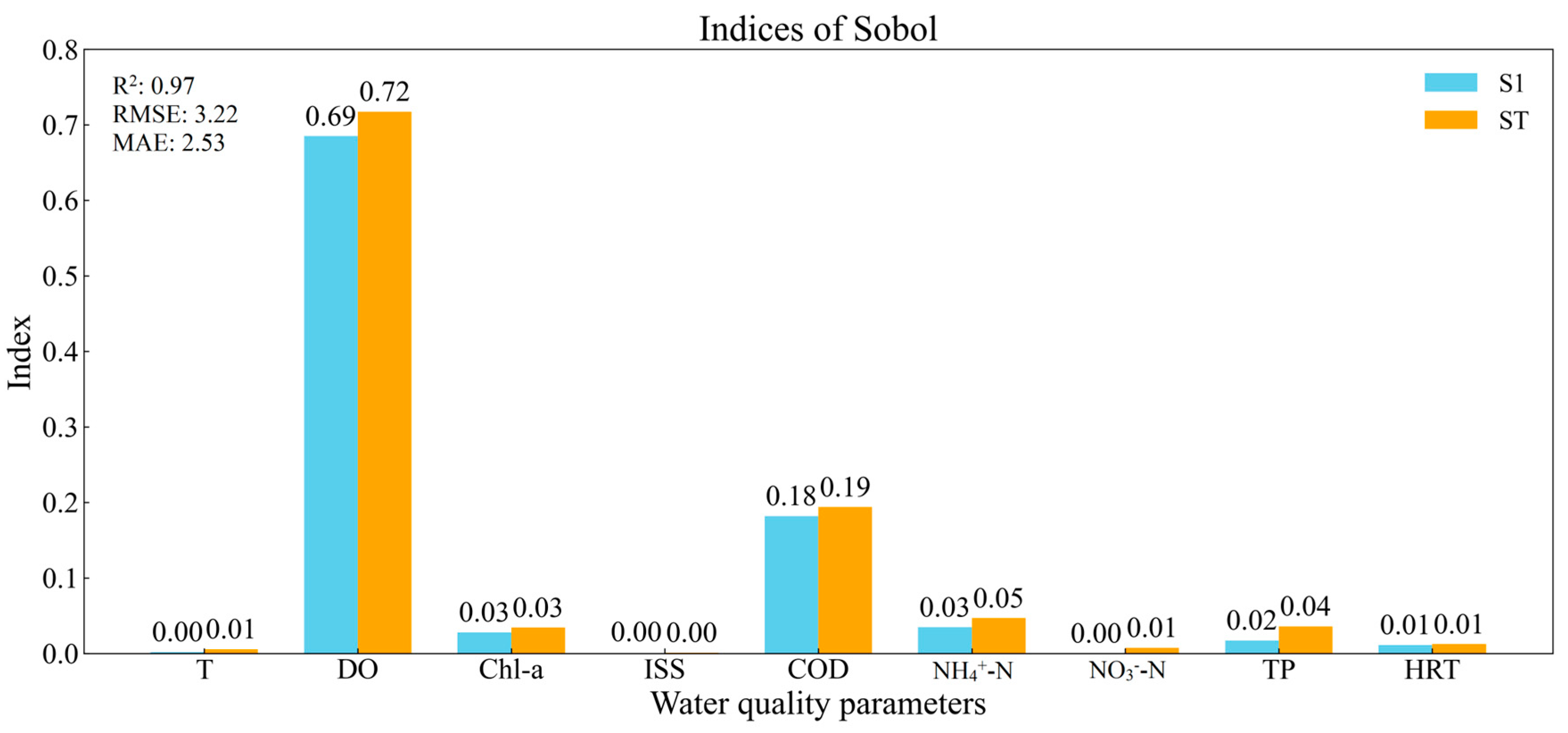


| No. | Water Body | Area /(ha) | Depth/(m) | Water Source | Function | Sampling Points | Remarks |
|---|---|---|---|---|---|---|---|
| 1 | Fores Park | 25.00 | 1.40 | Surface water | Landscape fuction | 3 | |
| 2 | Jinci Park | 20.00 | 1.50 | 2 | |||
| 3 | Yinmahe Park | 2.75 | 1.90 | 2 | Maintenance in Jul 2021 | ||
| 4 | Xihaizi Park | 1.30 | 1.9 | 2 | Maintenance in Jul–Aug 2021 | ||
| 5 | Nanhaizi Park | 1.40 | 1.9 | 2 | Maintenance in Jul–Aug 2021 | ||
| 6 | Yingze Park | 16.80 | 2.20 | 3 | |||
| 7 | Longtan Park | 16.50 | 2.55 | Tap water | 2 | Maintenance in Jul 2021 | |
| 8 | Hexie Park | 1.76 | 2.00 | 2 | |||
| 9 | Xiangyun Park | 3.27 | 1.5 | 2 | |||
| 10 | Heping Park | 2.62 | 2.00 | 1 | |||
| 11 | Zoo Park | 2.57 | 1 | 2 | |||
| 12 | Yifen Park | 0.23 | 1.5 | 2 | |||
| 13 | Beilin Park | 0.11 | 1.05 | 2 | |||
| 14 | Dongli Park | 0.3 | 1.8 | 2 | |||
| 15 | Xuefu Park | 5.26 | 1.20 | Rainwater | Landscape function, flood control | 2 | |
| 16 | Wenying Park | 3.96 | 2.40 | 2 |
| Sobol | Morris | ||||
|---|---|---|---|---|---|
| S1 | ST | μ | μ* | ||
| Hancheng Lake | ISS | 0.51 | 0.51 | −0.19 | 0.19 |
| Chla | 0.38 | 0.38 | −0.09 | 0.1 | |
| AN | 0 | 0 | 0.03 | 0.09 | |
| NN | 0.02 | 0.02 | 0.03 | 0.03 | |
| IP | 0.09 | 0.09 | 0.03 | 0.03 | |
| Xingqing Lake | ISS | 0.24 | 0.24 | −0.74 | 0.74 |
| Chla | 0.67 | 0.67 | −0.3 | 0.3 | |
| AN | 0.02 | 0.02 | 0 | 0 | |
| NN | 0 | 0 | 0 | 0 | |
| IP | 0.07 | 0.07 | 0 | 0 | |
Disclaimer/Publisher’s Note: The statements, opinions and data contained in all publications are solely those of the individual author(s) and contributor(s) and not of MDPI and/or the editor(s). MDPI and/or the editor(s) disclaim responsibility for any injury to people or property resulting from any ideas, methods, instructions or products referred to in the content. |
© 2024 by the authors. Licensee MDPI, Basel, Switzerland. This article is an open access article distributed under the terms and conditions of the Creative Commons Attribution (CC BY) license (https://creativecommons.org/licenses/by/4.0/).
Share and Cite
Zhou, Y.; Lv, Y.; Dong, J.; Yuan, J.; Hui, X. Sensitivity Analysis of Urban Landscape Lake Transparency Based on Machine Learning in Taiyuan City. Sustainability 2024, 16, 7026. https://doi.org/10.3390/su16167026
Zhou Y, Lv Y, Dong J, Yuan J, Hui X. Sensitivity Analysis of Urban Landscape Lake Transparency Based on Machine Learning in Taiyuan City. Sustainability. 2024; 16(16):7026. https://doi.org/10.3390/su16167026
Chicago/Turabian StyleZhou, Yuan, Yongkang Lv, Jing Dong, Jin Yuan, and Xiaomei Hui. 2024. "Sensitivity Analysis of Urban Landscape Lake Transparency Based on Machine Learning in Taiyuan City" Sustainability 16, no. 16: 7026. https://doi.org/10.3390/su16167026
APA StyleZhou, Y., Lv, Y., Dong, J., Yuan, J., & Hui, X. (2024). Sensitivity Analysis of Urban Landscape Lake Transparency Based on Machine Learning in Taiyuan City. Sustainability, 16(16), 7026. https://doi.org/10.3390/su16167026







